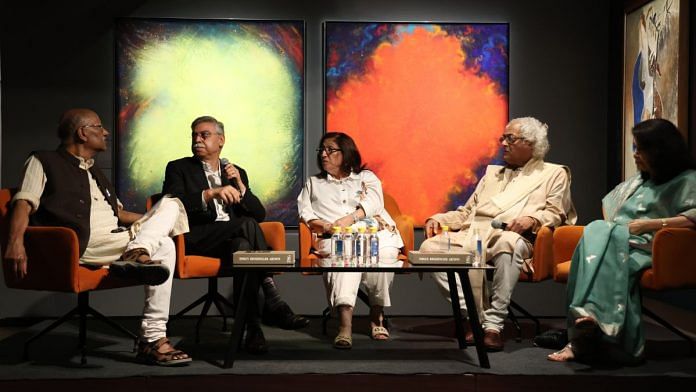New Delhi: The temporary rehoming of India’s priceless artefacts, relics, paintings and sculptures, housed at New Delhi’s National Museum, has caused much consternation among historians, artists and other experts.
“They do not even know how to store artworks,” said Kiran Nadar, chairperson of the Kiran Nadar Museum of Art, while weighing in on how the exercise has been carried out so far in a panel discussion at DAG on Tuesday.
The National Museum, along with the Indira Gandhi National Centre for the Arts (IGNCA) and the annexes of the National Archives of India, is slated to be subsumed by the Central Vista Museum project. It will be called the Yuge Yugeen Bharat National Museum, and cover 1.17 lakh square metres of the North and South Blocks in Raisina Hill. The new museum is billed to be the largest in the world.
But an advisory committee for the Central Vista Museum project has met only once so far, according to Tasneem Z Mehta, managing trustee and honorary director of Mumbai’s Dr Bhau Daji Lad Museum. The committee was formed over two years ago, in June 2022. Mehta, who was part of the panel, later told ThePrint that both she and art historian and curator Naman P Ahuja were invited to be a part of the advisory committee.
“At the meeting, we were asked how we would execute the project, and I gave a few suggestions,” said Mehta, adding that former Union Culture Secretary Govind Mohan had attended it as well.
“I think it’s a good project. It’s the management that needs to be more professional. Most of our important government museums are being run by bureaucrats,” she added.
Having been part of several similar committees in the past, she’s learned the importance of continuous pushing. Change depends on that one bureaucrat who has an interest in art and museums, she said.
However, historians and other experts have cautioned against moving priceless pieces of India’s history around. Earlier this year, the government went back on its decision to shift 2.1 lakh artefacts in the National Museum to a temporary location before they could be moved to the new museum.
“They are planning to build the largest museum in the world. First, look at the state of the museums that already exist,” said Nadar at the panel discussion, ‘Patronage as Legacy: Philanthropy as Institution-Building for the Arts’. Other panellists included Sunil Kant Munjal, businessman and founder of Serendipity Arts Festival, and Rajeev Sethi, chairman and founder of Asian Heritage Foundation. The discussion was moderated by ThePrint’s editor-in-chief, Shekhar Gupta.
“We must pay attention to the now, and it cannot be navel-gazing only about our ancient past, which is wonderful. But we need to continue it as well,’ said Mehta, who has worked with the government on various projects for more than 20 years.
Neglected artefacts, crumbling museums
The state of the National Museum mirrors the condition of India’s several state-run museums.
“There are artefacts and various departments in the museum, but for the past decade and more, there have been no trained officials to handle these artefacts,” said a National Museum official.
The panellists called for more attention to be given to all the museums that house India’s heritage.
In 2011, UNESCO published a report on the appalling conditions of India’s top eight museums, citing sub-standard maintenance, signage, and lighting, among other issues. According to The Hindu, in 2015, the Archaeological Survey of India wrote to the Union Culture Ministry about a 2 BC Yakshi statue and a 3 BC Mauryan lion at Kolkata’s Indian Museum that had been irreversibly damaged.
There have been a few instances of the successful transformation of dilapidated museums. But it has been a long and arduous journey. From 2003 to 2008, the Dr Bhau Daji Lad Museum underwent extensive and award-winning restoration and revitalisation. It was a joint venture by the Municipal Corporation of Greater Mumbai, the Indian National Trust for Art and Cultural Heritage, and the Jamnalal Bajaj Foundation.
Mehta, who had helped transform the museum, underscored the need for more advocacy.
“Unless there is footfall and people advocate for art, it is seen as an elitist preoccupation, and the government dismisses it,” she said while acknowledging that governments are not always the most informed patrons of art. Mehta’s expansion plan for the BDL museum is stuck in limbo.
“I am waiting for the Maharashtra elections to get over, and slowly, like Sisyphus pushing his rock, I will also start pushing again,” she said.
The National Museum is home to India’s past—from the Dancing Girl of Mohenjo-Daro to the statue of the Mother Goddess, as well as the Climbing Monkey and the Pashupati Seal.
“Once it [an artefact] is lost, that is it. You cannot recreate something like that. It is a marker of our civilisation,” said the National Museum official.
(Edited by Zoya Bhatti)






